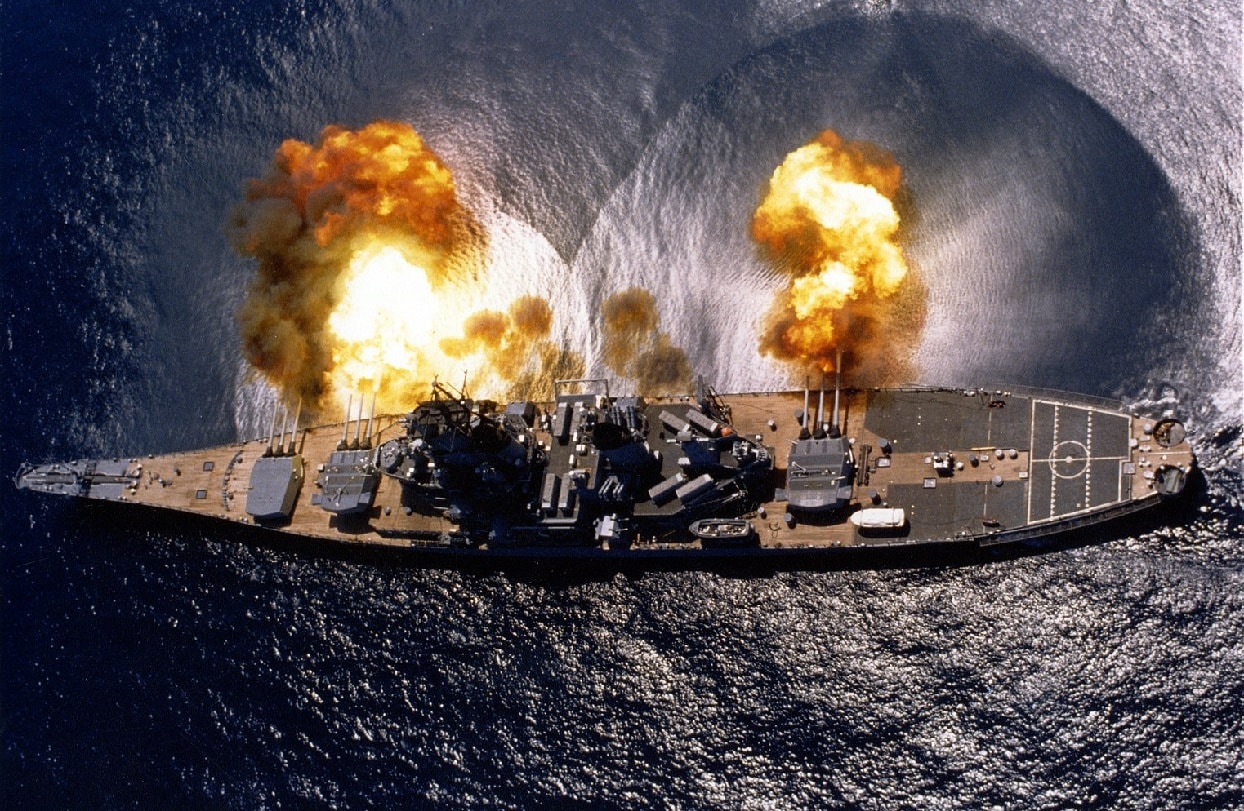Could the idea of a giant warship that is heavily armed, say 21st-century battleships, make a comeback?
Think of the Zumwalt but much bigger and more heavily armed. Is that possible?
Battleships: Coming Soon, But Bigger and Better
The concept of very large, heavily armed battleships may be making a comeback, a question that introduces relevant maritime warfare advantages and also raises some interesting questions.
Certainly, no one disputes the exceptional contributions made in history by major WWII, Korea, and Vietnam-era platforms such as Iowa-class Battleships and Alaska-class Battlecruisers, yet such large ships with unguided weapons might not only be less useful in a more dispersed, longer-range operational sphere, but they are also substantial targets for long-range precision-guided enemy weapons to attack.
Nonetheless, as far back as D-Day bombardments, the Korean War, or the Japanese WWII surrender on board the USS Missouri, battleships have carved a distinguished and lasting resting place in the hearts and minds of all Navy supporters for generations. Such a sentiment and time-honored reverence for maritime combat service is likely to endure into perpetuity to be sure, as few are likely to forget or ignore the US Navy’s WWII sacrifices and victories.
Alongside this important dynamic, there are tactical and strategic reasons why a return of large, heavily armed, and heavily armored battleships might make sense to return to the Navy’s maritime warfare fleet. In a simple sense, there will likely still be a need for heavily armored, high-volume land bombardment attacks moving into the future, should the Navy need to launch an amphibious attack or soften and destroy an adversaries’ land weapons, such as an anti-ship missile, to operate more safely closer to shore. The critical difference with any new battleship, it seems, would be the need to incorporate a large degree of paradigm-changing technological advances such as high-fidelity, long-range sensing and targeting, a new generation of weapons that include hypersonic projectiles, electromagnetic warfare (EW), and course-correcting cruise missiles and interceptors. Should a new generation of large battleships be engineered with these kinds of new technologies, including precision rounds and weaponry, indeed there might be a compelling argument to re-introduce the large battleship.
New generation of High-Tech Battleships
For example, in recent years the Navy has been experimenting with new precision rounds for its 5-inch deck-mounted weapons able to both triple the attack range and introduce unprecedented levels of precision. It is realistic to envision that this could incorporate course-correcting rounds, given that many already exist on land and in the form of new Tactical Tomahawk ship-fired cruise missiles.
The Zumwalt-class destroyers, for example, are slated to fire hypersonic weapons within just the next few years, something that massively improves the range, speed, and precision of maritime attack. Imagine if a large battleship were also armed with such weapons, fortified by modern, highly-networked, beyond-the-horizon sensors and targeting. This could be particularly impactful or relevant in anticipation of an amphibious attack in the event the U.S. Navy does not fully have air superiority.
Enemy ground defenses and offensive weapons such as mobile cruise missile launchers and ballistic missiles would need to be targeted, bombarded, and destroyed from offshore in advance of any amphibious ship-to-shore beach landing attack. Not only this, but well-positioned and well-armed battleships could supplement destroyers with firepower and have an impact on defending carriers needing to project air power.
There are yet several additional dimensions to this such as this question of ship defenses. Should large, potentially targetable battleships engage in high-risk missions in contested areas, they would need to greatly benefit from breakthrough layered ship defense technologies.
Those new systems with the largest impact might be weapons such as EW jammers able to find and “jam” the RF guidance of an incoming anti-ship missile, or laser interceptors able to track and incinerate incoming enemy drones, ballistic missiles, or enemy surface fire. Coupled with hypersonics and new over-the-horizon offensive missiles, battleships armed with these kinds of new defenses, interceptors and relay networking might be well positioned to bring a decisive impact to maritime warfare.
There is also the question of missile defense. For instance, if a SM-3 Block IIA is able to track and potentially intercept ICBMs with Aegis Radar combat systems descending into the earth’s atmosphere, a capability that has been demonstrated, then additional networked missile-defense nodes would bring new dimensions and angles of defensive capability for surface ships in position to strengthen a strategic deterrence posture.
Finally, something woven into this is the breakthrough kind of multi-domain networking technologies. Should battleships be able to coordinate targeting, command and control, and real-time intelligence and intelligence, surveillance, and reconnaissance (ISR) across surface air and undersea domains, then they would be further positioned with a tactical advantage. This would involve data analysis and transmission between surface ships, aerial drones, other surface vessels, and aerial “gateways” in position to see otherwise undetectable beyond the horizon incoming threats.
Multi-domain networking, fast-developing technology augmented by unmanned systems, and nodes, could further enable new, large high-tech battleships to bring paradigm-changing offensive and defensive maritime warfare possibilities to the Navy.
Kris Osborn is the Military Affairs Editor of 19FortyFive and President of Warrior Maven – Center for Military Modernization. Osborn previously served at the Pentagon as a Highly Qualified Expert with the Office of the Assistant Secretary of the Army—Acquisition, Logistics & Technology. Osborn has also worked as an anchor and on-air military specialist at national TV networks. He has appeared as a guest military expert on Fox News, MSNBC, The Military Channel, and The History Channel. He also has a Masters Degree in Comparative Literature from Columbia University.
From 19FortyFive
The 5 Best .22 LR Semiautomatic Pistols On Earth
Ukraine Footage Shows U.S. M982 ‘Excalibur’ Cut Through Russian Artillery
How To Sink A $3 Billion Dollar Submarine: Leave A Hatch Open

